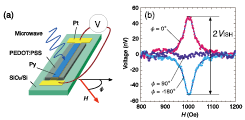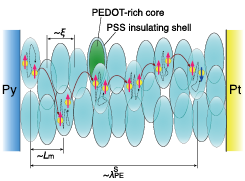Spin Transport and Relaxation Mechanism in a Disordered Organic Film
Otani Group
Organic semiconductors (OSCs) consist of relatively light elements such as carbon, hydrogen, and sulfur. Therefore, their spin-orbit (SO) interaction is expected to be weak. OSCs are thus expected to have long-distance spin transport since the spin relaxation is mainly caused by the SO interaction. In most of the OSCs, however, the electron conduction is dominated by hopping transport in the strongly disordered structure. Thus, the spin transport and relaxation mechanism is not well understood compared with the conventional metallic materials where the band-like transport is dominant.

Fig. 1. (a)Schematic of the device structure used for the spin pumping experiment. The applied magnetic field is rotated in the basal plane. (b)Magnetic field dependence of the ISHE voltage signal for ø = 0˚, 90˚ and 180˚. In this figure, only the symmetric voltage component on the FMR field is shown.

Fig. 2. Expected spin transport mechanism in the PEDOT:PSS layer. ξ, Lm, and λSPE denote the localization length, hopping length, and SDL of PEDOT:PSS, respectively. The spins do not flip during hopping conduction, but mostly flip while trapped in the PEDOT-rich cores.
Here we report our systematic studies on the spin transport and relaxation mechanism in an OSC PEDOT:PSS by means of spin pumping, charge transport, and electron paramagnetic resonance (EPR) experiments. The spin pumping experiment enables us to estimate the spin diffusion length (SDL), and the other two experiments to determine the spin diffusion constant (DS) and the spin lifetime (τS), respectively. The OSC used in this study is the conducting polymer PEDOT:PSS in which the conjugated PEDOT molecule is doped with PSS. The film consists of core-shell particles in which a PEDOT-rich core is covered with an insulating PSS shell: the electron transport is dominated by hopping conduction between the PEDOT-rich cores.
Figure 1(a) shows the device structure used in this spin pumping experiment. The device comprises a trilayer of ferromagnetic permalloy (Py), PEDOT:PSS, and platinum (Pt). These layers respectively act as spin injector, transport, and detector layers. In this experiment, the pure spin current accompanied by no net charge current is induced in the adjacent PEDOT:PSS layer by the interfacial exchange interaction during the ferromagnetic resonance (FMR) excitation. The injected pure spin current through the PEDOT:PSS is absorbed by the Pt layer, and then converted to the electric field via the inverse spin Hall (ISH) effect of the Pt layer. Figure 1(b) shows the magnetic field dependence of voltage signal at the Pt layer for ø = 0˚, 90˚ and 180˚. As can be seen in the figure, a clear voltage peak is observed at the FMR field. The voltage signal changes its sign when the magnetic field direction is inverted, and vanishes at ø = 90˚. This behavior is consistent with the ISH voltage signal (VISH) given by VISH ∝ JS× σ where JS is the spin current and σ is the spin polarization vector. From the PEDOT:PSS thickness dependence of VISH, we have determined the SDL of PEDOT:PSS layer as 140 ± 20 nm. By using the diffusion constant obtained from the charge transport experiment, we can estimate the spin lifetime (τSt ) as 28 ± 20 ns. To confirm this result, we have performed an EPR experiment of PEDOT:PSS which is an alternative method to determine the spin lifetime. The obtained spin lifetime (τSEPR) is in the range of 5-100 ns, and this value is reasonably consistent with τSt .
Now we consider the relationship between two spin lifetimes obtained by different experiments. In the present material PEDOT:PSS, the charge transport is dominated by the hopping conduction. Therefore, the electrons are first trapped at the PEDOT-rich core, and occasionally hop to adjacent cores, suggesting τSt is determined by both the trapping and hopping processes. On the other hand, the EPR experiment mainly gives the spin lifetime in the trapping state, i.e., the spin lifetime within the PEDOT-rich cores. The present study indicates that two spin lifetimes determined by two different experimental methods are reasonably consistent with each other. Moreover, we have revealed that the SDL is longer than the average hopping length (Lm) for one hopping process. These results suggest that most of the spins are not flipped during the hopping process, while the spin relaxation mainly takes place in the trapping state of the PEDOT-rich cores (Fig. 2).
